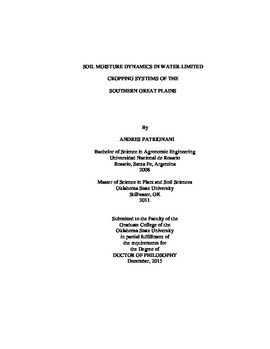| dc.contributor.advisor | Ochsner, Tyson E. | |
| dc.contributor.author | Patrignani, Andres | |
| dc.date.accessioned | 2017-02-22T22:11:39Z | |
| dc.date.available | 2017-02-22T22:11:39Z | |
| dc.date.issued | 2015-12 | |
| dc.identifier.uri | https://hdl.handle.net/11244/48921 | |
| dc.description.abstract | In this dissertation we present and discuss four research questions about the role of water in the water-limited cropping systems of the southern Great Plains. i) Why are wheat yields near stagnation in the southern Great Plains? Grain yield and growing season rainfall for a total of 19 Oklahoma counties were analyzed. Current yields represent 74% of the maximum attainable yield but only 30% of water-limited potential yield at state level. Wheat yields were often limited by factors other than growing season rainfall amount. ii) Is it possible to develop a simple and accurate tool to measure in situ vegetation conditions to inform crop models and in-season management decisions? A new tool called Canopeo was designed to quantify green canopy cover from digital images and videos. The rapid image processing and the accurate values of green canopy cover make Canopeo a useful tool with potential to better manage grazing and improve soil moisture estimations in winter wheat cropping systems. iii) Can we directly use soil moisture observations under grassland to represent the soil moisture condition of nearby wheat cropland? Grassland and winter wheat soil moisture dynamics were analyzed for 78 Oklahoma Mesonet stations. The use of a neural network as an observation operator proved to be effective to capture the main soil moisture dynamics under winter wheat cropland. This study revealed that there is inscribed information in the soil moisture time series under grassland vegetation that allow estimates of soil moisture in nearby cropland. iv) Do plants growing in the same soil start to decline the transpiration rate at higher soil water contents under higher atmospheric demands? What is the nature of that relationship? Corn plants were grown in a controlled-environment chamber under atmospheric demands of 4.8 and 8.4 mm d-1 reference evapotranspiration. Relative plant transpiration rate (actual rate/potential rate) started to consistently decline at a soil matric potential similar to that at the inflection point of the soil water retention curve, regardless of the atmospheric demand. A double exponential function proved effective to describe the relationship between relative transpiration and soil matric potential for different soil and atmospheric demands. | |
| dc.format | application/pdf | |
| dc.language | en_US | |
| dc.rights | Copyright is held by the author who has granted the Oklahoma State University Library the non-exclusive right to share this material in its institutional repository. Contact Digital Library Services at lib-dls@okstate.edu or 405-744-9161 for the permission policy on the use, reproduction or distribution of this material. | |
| dc.title | Soil moisture dynamics in water-limited cropping systems of the southern Great Plains | |
| dc.contributor.committeeMember | Warren, Jason | |
| dc.contributor.committeeMember | Edwards, Jeffrey T. | |
| dc.contributor.committeeMember | Wilson, Duncan S. | |
| osu.filename | Patrignani_okstate_0664D_14447.pdf | |
| osu.accesstype | Open Access | |
| dc.type.genre | Dissertation | |
| dc.type.material | Text | |
| thesis.degree.discipline | Soil Science | |
| thesis.degree.grantor | Oklahoma State University | |
